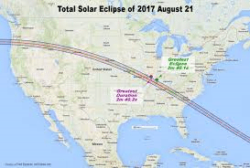
“We’re expecting a good experience but there will be [peak] times where the network will struggle,” said Paula Doublin, assistant vice president of construction and engineering for AT&T. According to The Bulletin, emergency personnel are concerned with the convergence of a high population in some areas as well, including those in Central Oregon. They fear the towers won’t be able to handle the bandwidth and in the case of an emergency, 911 calls via cell phones won’t be possible. Their plan is to rely on “older” methods of communication – landlines and ham radio operators – to fill the gap.
“We are expecting more people in our state for a special event than potentially we have ever had,” Oregon Office of Emergency Management Spokesperson Cory Grogan told The Bulletin.
Verizon, AT&T, and Sprint plan to provide portable towers in certain locations along the eclipse’s path, including Oregon, Missouri, Illinois, Kentucky, Wyoming, and Idaho. Not all temporary tower locations are yet finalized.
According to the Daily Times, the Total Solar Eclipse will begin in Oregon (at approximately 11:35 a.m.) and cut diagonally across 14 states, hitting Missouri and Illinois at 1:15 p.m. and 1:25 p.m., respectively, and ending in South Carolina around 2:30 p.m. The best places to see the eclipse – when the moon completely blocks out the sun – is in the “path of totality,” where there will be periods of total darkness up to two minutes and 40 seconds in length. These areas happen to be in rural locations, where cell service is already spotty. And with tens of thousands to upwards of one million people expected in some areas, wireless capacity will be a challenge.
Watch the video here.
August 1, 2017




Reader Interactions